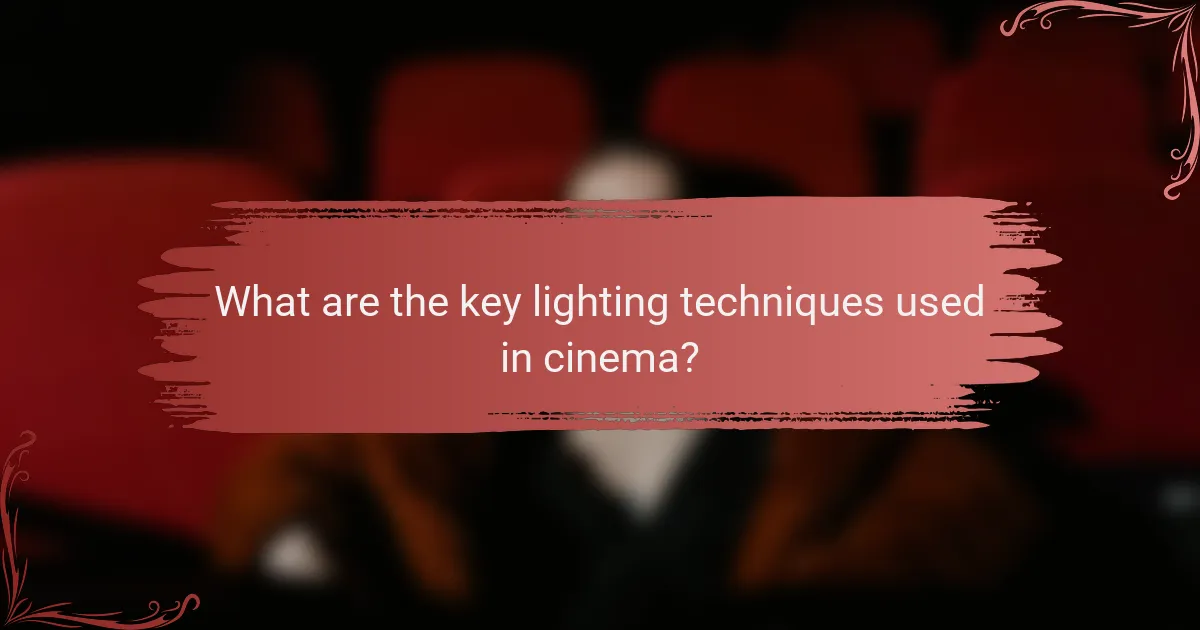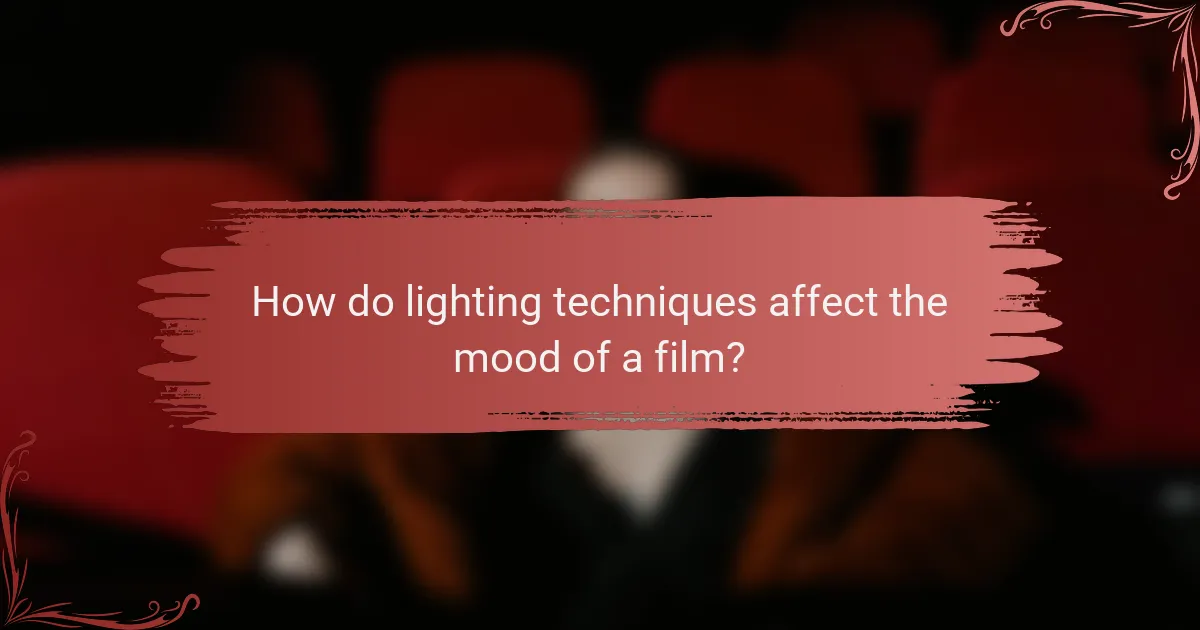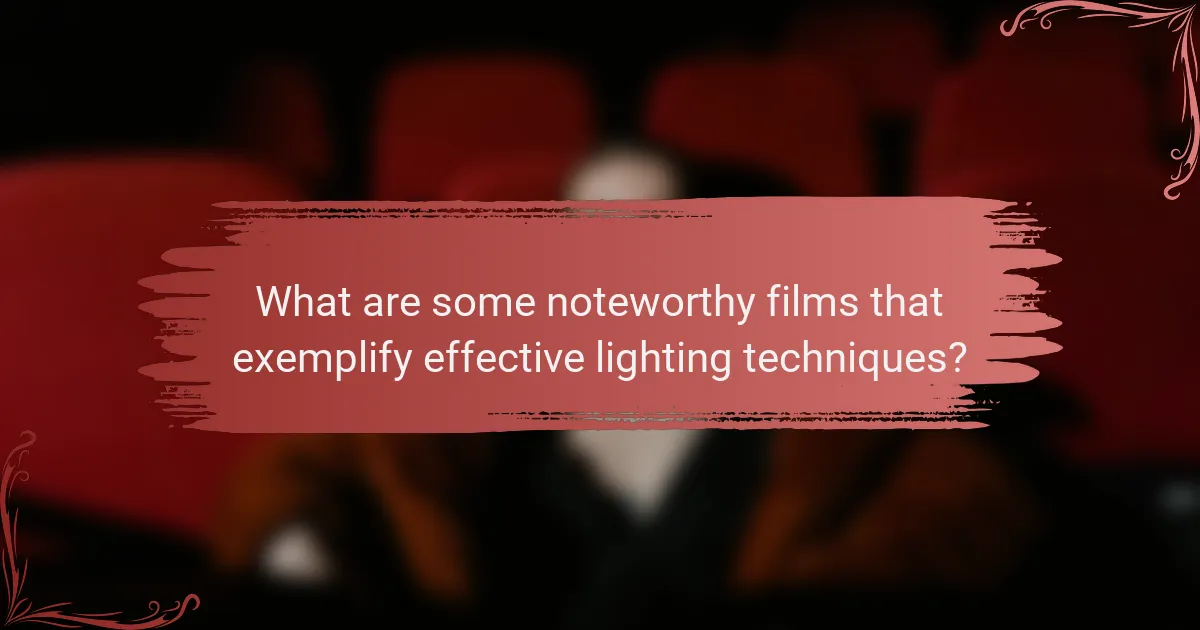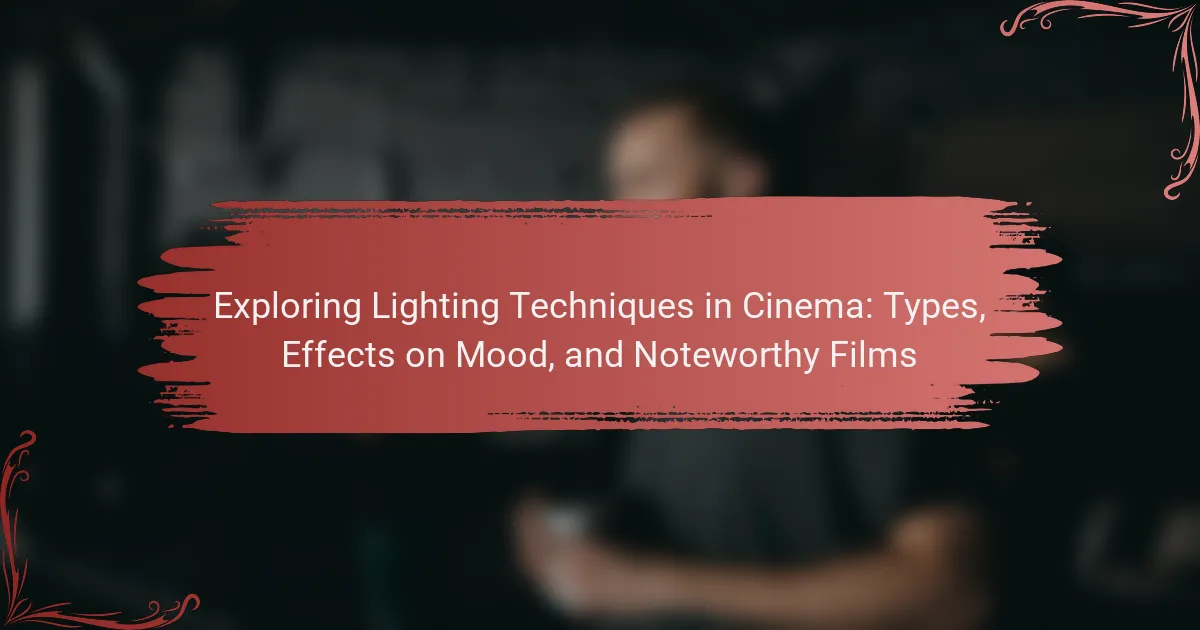Lighting techniques in cinema play a crucial role in shaping the mood and tone of films. Key lighting methods include three-point lighting, high-key lighting, and low-key lighting, each serving distinct purposes in visual storytelling. Three-point lighting employs a combination of key light, fill light, and back light to create depth, while high-key lighting offers bright, even illumination suitable for comedies, and low-key lighting emphasizes shadows for tension in horror and thriller genres. The article explores how these techniques, along with natural and practical lighting, influence audience emotions and perceptions, highlighting notable films like “Blade Runner,” “The Godfather,” and “Inception” that exemplify effective lighting use.

What are the key lighting techniques used in cinema?
Key lighting techniques used in cinema include three-point lighting, high-key lighting, and low-key lighting. Three-point lighting involves the use of a key light, fill light, and back light to create depth and dimension. High-key lighting produces a bright, even illumination that minimizes shadows. This technique is often used in comedies and musicals to create a light-hearted atmosphere. Low-key lighting, on the other hand, emphasizes shadows and contrast. It is frequently employed in horror and thriller genres to evoke tension and suspense. Other techniques include natural lighting, which utilizes sunlight, and practical lighting, which incorporates visible light sources within the scene. These techniques significantly influence the mood and tone of a film.
How do different lighting techniques influence visual storytelling?
Different lighting techniques significantly influence visual storytelling by shaping mood, emphasizing character, and guiding viewer attention. High-key lighting creates a bright, cheerful atmosphere, often used in comedies. Conversely, low-key lighting generates suspense and tension, commonly found in thrillers and horror films. Natural lighting can evoke realism, grounding the story in authenticity.
Directional lighting highlights specific elements, enhancing dramatic moments or character emotions. For example, chiaroscuro lighting creates stark contrasts, emphasizing the duality of characters. Color temperature also plays a role; warm tones can evoke comfort, while cool tones may suggest isolation or danger.
Research shows that lighting impacts viewer perception and emotional response. A study by Smith et al. (2020) in the Journal of Visual Communication found that lighting choices directly affect audience interpretation of scenes. Thus, different lighting techniques are essential tools in visual storytelling, shaping narrative and emotional depth.
What are the characteristics of high-key lighting?
High-key lighting is characterized by bright illumination and minimal shadows. It creates an overall even light distribution. This lighting technique often results in a cheerful and upbeat mood. High-key lighting is commonly used in comedies and musicals. It typically involves using multiple light sources to reduce contrast. The color palette in high-key lighting is usually vibrant and lively. It enhances [censured] features and textures without harsh shadows. High-key lighting is effective for conveying a sense of optimism and clarity.
What are the effects of low-key lighting on audience perception?
Low-key lighting creates a dramatic effect that influences audience perception. It involves strong contrasts between light and shadow. This technique often evokes feelings of tension and suspense. Audiences may perceive characters as mysterious or threatening under low-key lighting. The shadows can obscure details, enhancing intrigue. Studies show that low-key lighting can enhance emotional engagement. For example, in film noir, this lighting style reinforces themes of danger and moral ambiguity. Overall, low-key lighting shapes how viewers interpret scenes and characters.
What role does natural lighting play in filmmaking?
Natural lighting plays a crucial role in filmmaking by enhancing realism and mood. It creates a natural atmosphere that resonates with viewers. Natural light can highlight textures and colors effectively. This type of lighting often reduces the need for additional equipment and setup time. Filmmakers can use it to create specific times of day, like golden hour or harsh midday sun. Using natural light can also lead to dynamic and spontaneous shots. Many acclaimed films, such as “The Revenant,” utilize natural lighting for authenticity. Studies show that natural light can evoke emotional responses from audiences, enhancing storytelling.
How can filmmakers effectively use natural light in their scenes?
Filmmakers can effectively use natural light by planning scenes around the time of day and weather conditions. They should utilize the golden hour, which occurs shortly after sunrise and before sunset, for soft, flattering light. Positioning subjects to face the light enhances visibility and creates depth. Using reflectors can bounce light onto subjects, filling in shadows without losing the natural feel. Filmmakers should also be aware of the direction of light, as side lighting can add texture and dimension. Adjusting camera angles can capture the best quality of natural light. Lastly, incorporating practical elements like windows can enhance the scene’s authenticity.
What challenges do filmmakers face when using natural light?
Filmmakers face several challenges when using natural light. The primary challenge is the unpredictability of weather conditions. Changes in sunlight can affect continuity in scenes. Another issue is the varying quality of light throughout the day. This can lead to inconsistent lighting across shots. Additionally, filmmakers must contend with shadows and highlights that can be harsh. This can impact the overall aesthetic of the film. Filmmakers also have limited control over the environment. External factors like reflections and ambient light can interfere with desired lighting effects. These challenges require careful planning and adaptability during shoots.
What are the differences between artificial and natural lighting techniques?
Artificial lighting techniques use man-made light sources, while natural lighting techniques rely on sunlight. Artificial lights include bulbs, LEDs, and other fixtures. They offer control over intensity and color temperature. This allows for consistent lighting regardless of time or weather. Natural light changes throughout the day, affecting mood and atmosphere. It can create soft shadows and highlights. Natural light is often preferred for its authenticity and warmth. However, it is less predictable than artificial light. Filmmakers often combine both techniques for desired effects.
How does artificial lighting enhance specific scenes?
Artificial lighting enhances specific scenes by controlling visibility and influencing mood. It allows filmmakers to highlight key elements within a frame. For instance, soft lighting can create an intimate atmosphere. Conversely, harsh lighting can evoke tension or discomfort. Different colors of artificial light can also impact emotional responses. Warm tones often suggest comfort, while cool tones may indicate detachment. Additionally, artificial lighting can simulate natural light conditions, making scenes more believable. Studies show that lighting significantly affects audience perception and engagement. This technique is essential in creating a desired narrative impact.
What types of artificial lights are commonly used in cinema?
Common types of artificial lights used in cinema include LED lights, tungsten lights, and fluorescent lights. LED lights are energy-efficient and versatile, often used for key lighting. Tungsten lights provide a warm color temperature, making them ideal for indoor scenes. Fluorescent lights are commonly used for fill lighting due to their soft quality. Each type serves specific functions in creating desired visual effects. For instance, LED lights can be adjusted for intensity and color, enhancing creative flexibility. Tungsten lights are favored for their natural skin tones, while fluorescent lights help in achieving a balanced illumination.

How do lighting techniques affect the mood of a film?
Lighting techniques significantly influence the mood of a film. Different lighting styles can evoke various emotions and perceptions. For instance, high-key lighting creates a bright and cheerful atmosphere. This technique often utilizes soft shadows and even illumination. Conversely, low-key lighting produces a darker, more suspenseful mood. It employs strong contrasts and deep shadows to enhance tension. Colors used in lighting also play a crucial role. Warm tones can create feelings of comfort, while cool tones may induce unease. Studies have shown that lighting directly affects audience emotional responses, reinforcing the narrative. Effective use of lighting can transform a scene’s impact and viewer engagement.
What emotions can be conveyed through lighting choices?
Lighting choices can convey a range of emotions in cinema. Bright lighting often expresses happiness and optimism. Soft lighting can create a sense of intimacy and warmth. Dark lighting typically evokes feelings of mystery or fear. Harsh lighting may induce tension or discomfort. Color temperature also plays a role; warm tones suggest comfort, while cool tones can imply sadness or detachment. High contrast lighting can enhance drama and conflict. These emotional cues are used strategically by filmmakers to influence audience perception and engagement.
How does warm lighting influence audience emotions?
Warm lighting influences audience emotions by creating a sense of comfort and relaxation. This type of lighting often evokes feelings of warmth, intimacy, and safety. Research shows that warm colors, such as yellows and oranges, can stimulate feelings of happiness and contentment. A study published in the journal “Color Research and Application” found that warm lighting can enhance positive emotional responses in viewers. Additionally, warm lighting has been used effectively in films to set a nostalgic or romantic mood. This emotional impact is crucial in storytelling, as it helps to engage the audience on a deeper level.
What impact does cool lighting have on mood and tone?
Cool lighting generally creates a calm and focused atmosphere. It often evokes feelings of tranquility and detachment. This type of lighting can enhance the emotional depth of a scene. Studies show that cool tones can reduce feelings of warmth and intimacy. For instance, research indicates that blue lighting can lower heart rates. This physiological response contributes to a more subdued mood. In cinema, cool lighting is frequently used in dramatic or suspenseful scenes. It helps convey tension and emotional distance.
Why is lighting considered a crucial element in creating atmosphere?
Lighting is considered a crucial element in creating atmosphere because it influences the emotional tone of a scene. Different lighting techniques can evoke various feelings, such as warmth, tension, or mystery. For instance, soft lighting creates a romantic ambiance, while harsh lighting can convey unease. The direction of light also affects perception; low-angle lighting can make subjects appear more powerful. Color temperature plays a significant role as well; warm tones often feel inviting, while cool tones can feel sterile or cold. Studies show that lighting can alter viewer perception and engagement with the narrative. In cinema, effective lighting design enhances storytelling by guiding audience emotions and reactions.
How do shadows contribute to the overall mood of a scene?
Shadows significantly influence the overall mood of a scene. They create depth and dimension, enhancing visual interest. Shadows can evoke feelings of mystery or tension. For instance, low-key lighting often uses shadows to generate suspense. In contrast, soft shadows can create a sense of calm and warmth. The presence and intensity of shadows can also indicate time of day or emotional states. Research shows that shadows affect viewer perception and emotional response. A study by K. H. K. Lee et al. in 2018 found that shadows enhance the dramatic impact of visual storytelling. Thus, shadows are essential for shaping the audience’s emotional experience in cinema.
What is the significance of color temperature in lighting design?
Color temperature is significant in lighting design as it influences the mood and perception of a space. It is measured in Kelvin (K) and ranges from warm (below 3000K) to cool (above 5000K) temperatures. Warm light creates a cozy and inviting atmosphere, suitable for intimate settings. In contrast, cool light promotes alertness and focus, often used in work environments. The choice of color temperature affects how colors appear in a scene, impacting visual storytelling in cinema. For instance, daylight-balanced lighting (around 5600K) can enhance realism in outdoor scenes. Research shows that color temperature can evoke specific emotional responses, making it a powerful tool in lighting design.
How can lighting be used to foreshadow events in a story?
Lighting can foreshadow events in a story by creating visual cues that suggest future outcomes. For instance, low lighting can indicate danger or tension, hinting at upcoming conflict. Conversely, bright lighting may signify safety or happiness, suggesting positive developments. Specific colors in lighting also play a role; red might foreshadow violence or passion, while blue can imply sadness or coldness. Filmmakers often manipulate shadows to create uncertainty, leading audiences to anticipate surprises. Historical examples include “The Godfather,” where dim lighting signifies impending betrayal. Such techniques guide viewer emotions and expectations, enhancing narrative depth.
What are examples of films that effectively use lighting for foreshadowing?
“Blade Runner” uses lighting to create a sense of impending doom. The film’s neon lights contrast with dark shadows, hinting at the characters’ fates. “The Sixth Sense” employs low-key lighting to foreshadow supernatural elements. Key scenes are shrouded in darkness, enhancing suspense. “The Godfather” utilizes chiaroscuro lighting to suggest moral ambiguity. The interplay of light and shadow reflects the characters’ internal conflicts. “A Clockwork Orange” uses stark lighting to foreshadow violence. Bright, harsh lights highlight the protagonist’s disturbing actions. “The Shining” incorporates ominous lighting to build tension. The eerie glow of the hotel suggests lurking dangers. These films demonstrate how lighting can effectively foreshadow events and enhance storytelling.
How does lighting guide audience expectations throughout a film?
Lighting guides audience expectations in film by establishing mood and tone. Different lighting techniques evoke specific emotional responses. For instance, high-key lighting creates a bright, cheerful atmosphere. Conversely, low-key lighting can generate suspense or tension. The color temperature of lighting also influences perceptions. Warm tones often suggest comfort, while cool tones may imply danger. Consistent lighting styles help audiences anticipate narrative developments. For example, a shift in lighting can signal a character’s transformation. Studies show that lighting significantly impacts viewer engagement and interpretation. Overall, effective lighting shapes the storytelling experience.

What are some noteworthy films that exemplify effective lighting techniques?
“Blade Runner” showcases innovative use of neon lighting and shadows. “The Godfather” employs low-key lighting to enhance drama. “Inception” utilizes natural light to create surreal environments. “Moonlight” uses color grading to evoke emotion. “Schindler’s List” features stark contrasts to highlight tragedy. “The Revenant” employs natural lighting for realism. Each film demonstrates how lighting shapes visual storytelling and mood.
Which films are renowned for their innovative use of lighting?
“Blade Runner” is renowned for its innovative use of lighting. The film employs high-contrast lighting to create a dystopian atmosphere. “Citizen Kane” is another example, known for its chiaroscuro lighting techniques. The use of shadows in “The Godfather” enhances its dramatic intensity. “2001: A Space Odyssey” features unique lighting to depict space and technology. “The Revenant” utilizes natural light to create a raw and immersive experience. These films exemplify how lighting can significantly influence storytelling and viewer perception.
What lighting techniques were used in “Blade Runner” to create its iconic look?
“Blade Runner” utilized high-contrast lighting techniques to achieve its iconic look. The film employed chiaroscuro lighting, emphasizing stark contrasts between light and shadow. This technique created a moody and atmospheric environment. Neon lights were prominently featured, contributing to the film’s futuristic aesthetic. Backlighting was also used to enhance silhouettes and depth. Moreover, practical lights in the set design added realism and texture to scenes. The use of fog and smoke diffused light, creating a dreamlike quality. These combined techniques established the film’s distinctive visual style and contributed to its lasting impact in cinema.
How did “The Godfather” utilize lighting to enhance its themes?
“The Godfather” utilized lighting to enhance its themes by creating a stark contrast between light and shadow. This chiaroscuro technique underscores the moral ambiguity of the characters. Key scenes feature dimly lit interiors, which evoke a sense of foreboding and tension. The use of shadows often represents the characters’ hidden motives and internal conflicts. For instance, the iconic scene of Vito Corleone in his dark office highlights his power and isolation. Additionally, the lighting in the wedding scene is bright and festive, contrasting sharply with the darker themes that unfold later. This juxtaposition reflects the duality of family loyalty and criminality. Overall, the strategic use of lighting in “The Godfather” deepens the narrative and reinforces its complex themes.
What lessons can filmmakers learn from these noteworthy films?
Filmmakers can learn the importance of lighting in shaping mood and storytelling from noteworthy films. Effective lighting techniques enhance emotional resonance and visual appeal. For instance, “Blade Runner” uses low-key lighting to create a noir atmosphere. This contributes to the film’s themes of isolation and dystopia. Similarly, “The Godfather” employs chiaroscuro lighting to highlight character dynamics and moral ambiguity. These examples illustrate that thoughtful lighting choices can deepen narrative impact. Moreover, filmmakers should consider how color temperature influences audience perception. Warm lighting evokes comfort, while cool tones can induce tension. Understanding these principles enables filmmakers to craft more engaging cinematic experiences.
How can aspiring filmmakers apply these lighting techniques in their work?
Aspiring filmmakers can apply lighting techniques by understanding their impact on storytelling. They should experiment with three-point lighting to create depth and dimension. This technique involves key, fill, and back lights to enhance the subject’s features. Additionally, using natural light can add realism to scenes. Filmmakers can also manipulate shadows to evoke specific emotions. For instance, harsh shadows can create tension, while soft lighting conveys warmth. They should analyze notable films that effectively use lighting, such as “Blade Runner” for its atmospheric effects. By practicing these techniques, filmmakers can improve their visual storytelling significantly.
What common mistakes should filmmakers avoid when working with lighting?
Filmmakers should avoid overexposing or underexposing their shots. Proper exposure ensures details are visible and maintains the intended mood. Another mistake is neglecting the direction of light. Light direction affects shadows and highlights, influencing the overall visual impact. Using too many light sources can create confusion in the scene. Simplicity often leads to a more cohesive look. Filmmakers should also avoid using harsh lighting without softening techniques. Soft light flatters subjects and creates a more inviting atmosphere. Ignoring color temperature is another common error. Consistent color temperature across shots maintains visual harmony. Lastly, failing to consider practical lights can detract from realism. Practical lights enhance the authenticity of a scene.
What practical tips can enhance lighting in independent films?
To enhance lighting in independent films, utilize natural light effectively. Position actors near windows or outdoor settings during the golden hour for optimal results. Use reflectors to bounce light and fill shadows, improving the overall quality. Experiment with practical lights like lamps or candles to create ambiance. Control lighting with dimmers to adjust intensity for different scenes. Consider using colored gels to alter the mood and tone of a scene. Invest in affordable LED lights for flexibility and portability. Lastly, plan your lighting setup during pre-production to ensure efficiency on set.
The main entity of the article is lighting techniques in cinema. The article explores various lighting techniques, including three-point lighting, high-key lighting, and low-key lighting, and their effects on visual storytelling and audience perception. It discusses the characteristics of high-key and low-key lighting, the role of natural and artificial lighting, and how these techniques influence the mood and tone of films. Additionally, it highlights notable films that exemplify effective lighting use and offers practical tips for filmmakers to enhance lighting in their projects. Overall, the article provides a comprehensive overview of how lighting shapes cinematic experiences.
